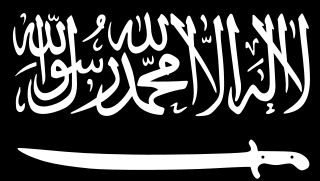
Shamil Salmanovich Basayev, also known by his kunya "Abu Idris", was a Chechen guerrilla leader who served as a senior military commander in the breakaway Chechen Republic of Ichkeria. He held the rank of brigadier general in the Armed Forces of Ichkeria, and was posthumously declared generalissimo. As a military commander in the separatist armed forces of Chechnya, one of his most notable battles was the separatist recapture of Grozny in 1996, which he personally planned and commanded together with Aslan Maskhadov. He also masterminded several of the worst terrorist attacks that occurred in Russia.

Nalchik is the capital city of Kabardino-Balkaria, Russia, situated at an altitude of 550 meters (1,800 ft) in the foothills of the Caucasus Mountains; about 100 kilometers (62 mi) northwest of Beslan. It covers an area of 131 square kilometers (51 sq mi). Population: 247,054 (2021 Census); 240,203 (2010 Census); 274,974 (2002 Census); 234,547 (1989 Soviet census).
The Beslan school siege, also referred to as the Beslan school hostage crisis or the Beslan massacre, was an Islamic terrorist attack that started on 1 September 2004. It lasted three days, and involved the imprisonment of more than 1,100 people as hostages, including 777 children, ending with the deaths of 334 people, 186 of them children, as well as 31 of the attackers. It is considered the deadliest school shooting in history.

Ali Musaevich Taziev, also known as Akhmed Yevloev, Magomet Yevloyev, and Emir Magas; born 19 August 1974) is the former leader of both the Ingushetia-based Ingush Jamaat and as the military wing of the Caucasus Emirate. On 30 September 2006, Taziev was appointed to the post of commander of the Caucasian Front by the orders of Dokka Umarov. In July 2007, one year after Shamil Basayev’s death, Taziev became his official successor as the most high-ranking military commander in the rebel forces. He is believed to be personally responsible for the death of several local high-ranking security officials.

Doku Khamatovich Umarov, also known as Dokka Umarov as well as by his Arabized name of Dokka Abu Umar, was a Chechen militant in the North Caucasus. Umarov was a major military figure in both wars in Chechnya during the 1990s and 2000s, before becoming the leader of the greater insurgency in the North Caucasus. He was active mostly in south-western Chechnya, near and across the borders with Ingushetia and Georgia.
The Nazran raid was a large-scale raid carried out in the Republic of Ingushetia, Russia on the night of June 21–22, 2004, by a group of Chechen militants led by Chechen commanders Shamil Basayev and Dokku Umarov. Basayev's main goal, besides capturing a large cache of weapons, was a show of strength. The attack by Chechen fighters on the Ingush city of Nazran is associated with the bad attitude of the Ingush authorities towards Chechen refugees.

Ruslan Anatolyevich Odizhev, born as Ruslan Anatolyevich Seleznyov (Селезнёв), was a citizen of Russia who was held in extrajudicial detention in the United States Guantanamo Bay detention camps, in Cuba. His Guantanamo Internment Serial Number was 211 and he was listed as "Ruslan Anatolivich Odijev, born at Prolandnom, Russia".

The United Vilayat of Kabarda-Balkaria-Karachay, also known as Vilayat KBK, was a militant Islamist Jihadist organization connected to numerous attacks against the local and federal security forces in the Russian republics of Kabardino-Balkaria and Karachay-Cherkessia in the North Caucasus. Vilayet KBK has been a member of the Caucasus Emirate group since 2007.

Anzor Astemirov, also known as Emir Sayfullah, was an Islamist leader in the republic of Kabardino-Balkaria, in the North Caucasus.
Anatoly Sultanovich Kyarov was the head of the Russia's Kabardino-Balkaria republic's UBOP. He and his UBOP squad were accused of serious human rights abuses within Kabardino-Balkaria, including of torture and murder.
Muslim Atayev, also known as Emir Sayfullah, was the founder of the militant organization Yarmuk Jamaat, which later became part of the Caucasus Front's Kabardino-Balkarian Sector in the Russian-held Caucasian Muslim state Kabardino-Balkaria of the Second Chechen War. Atayev was an ethnic Balkar and started his military career as a volunteer fighting in Chechnya.

Ilyas (Ilias) Gorchkhanov was the first leader of the Ingush Jamaat, which later became part of the Caucasus Front's Ingushetian Sector in Ingushetia of the Second Chechen War.

The insurgency in the North Caucasus was a low-level armed conflict between Russia and militants associated with the Caucasus Emirate and, from June 2015, the Islamic State, in the North Caucasus. It followed the (Russian-proclaimed) official end of the decade-long Second Chechen War on 16 April 2009. It attracted volunteers from the MENA region, Western Europe, and Central Asia. The Russian legislation considers the Second Chechen War and the insurgency described in this article as the same "counter-terrorist operations on the territory of the North Caucasus region".
Asker Dzhappuyev also known as Emir Abdullah, was the leader of the Jihadist United Vilayat of Kabarda-Balkaria-Karachay organisation in the Russian Republic of Kabardino-Balkaria.

The Insurgency in Kabardino-Balkaria and Karachay-Cherkessia was a protracted conflict between Russian security forces and militant groups operating in the regions of Kabardino-Balkaria and Karachay-Cherkessia, located in the North Caucasus region of Russia. The conflict was part of the broader insurgency in the North Caucasus, which emerged following the end of the First Chechen War in 1996.












